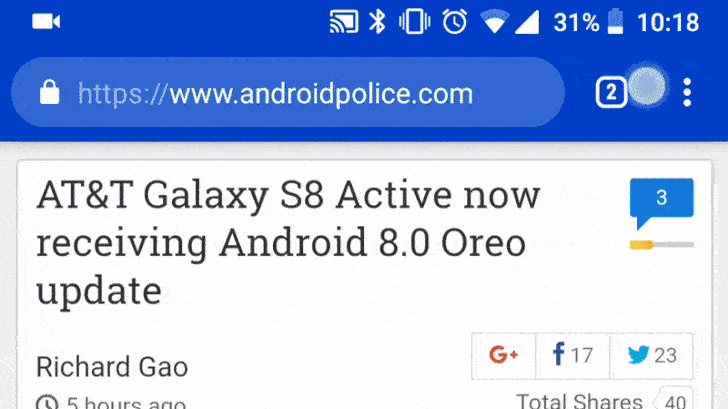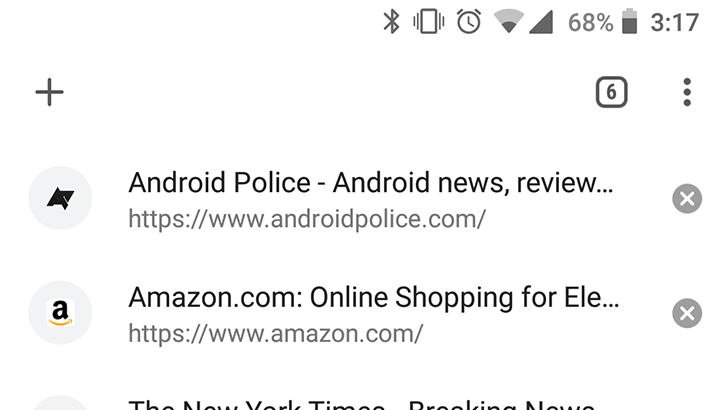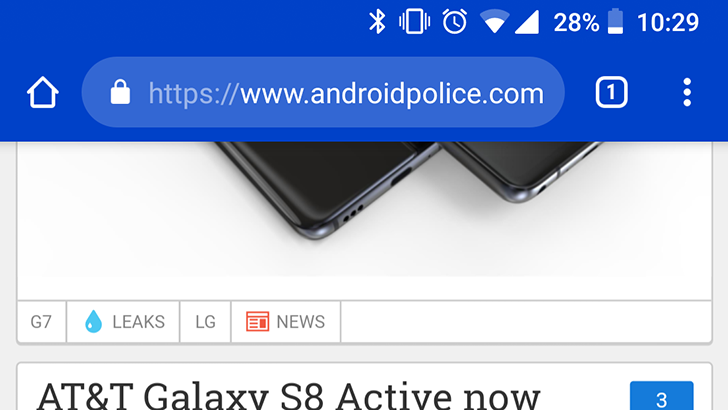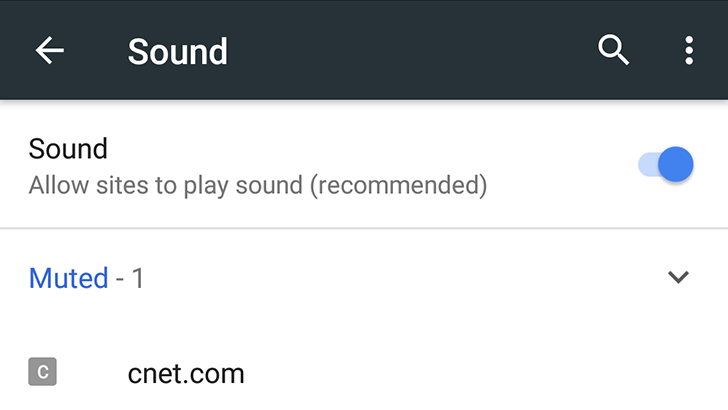15 tips and tricks for Chrome on Android (2019 edition)

#1: Hide recommended articles
By default, the New Tab Page in Chrome for Android shows recommended articles below the search bar and site shortcuts. If you don't want to see the recommendations, there's a hidden setting to disable them entirely.
Left: Articles turned on; Right: Articles turned off.
Copy and paste chrome://flags/#enable-ntp-remote-suggestions into the address bar, tap the dropdown menu, select 'Disabled,' then restart the browser when asked. After that, the articles should be gone.
#2: Receive Facebook and Twitter notifications in Chrome
The Facebook app for Android has never been great, especially in light of recent events. Twitter's app is less awful, but if you don't use the service frequently, you might not want the app taking up storage. Thankfully, you can receive notifications from both services through Chrome (or Firefox, or Samsung Internet).
For Facebook, log into the site on your device, tap the menu icon on the top right of the page, and scroll down to 'Account Settings.' Then tap 'Notifications' and press the 'Turn on' button.
For Twitter, log into mobile.twitter.com and tap on the notifications button. You should see an option for turning on push notifications. If not, tap the settings button on the top-right corner, select 'Push Notifications,' and then press 'Turn on.'
#3: Switch tabs with a swipe
The most obvious way to change tabs in Chrome is by pressing the tabs button and selecting the one you want from the list. But there are two other ways to change the current tab. You can swipe left and right across the address bar, or swipe down on the bar to see the full stack of tabs.
#4: Enable dark mode
The long-awaited dark mode for Chrome on Android arrived in April, but it's not enabled by default for everyone quite yet. Thankfully, it's easy to make the switch appear if you don't see it already.
Dark mode can be found by tapping the menu button at the top-right, tapping Settings, and selecting the 'Theme' menu. Here you can set dark mode to be enabled when your phone switches to it (this only works on some phones, or any devices with Android Q or newer), or force dark mode to always be on.
Dark mode on Chrome
If you don't see the Themes menu, copy and paste chrome://flags#enable-android-night-mode into the address bar, tap the highlighted dropdown menu, set it to 'Enabled,' and then restart the browser. You might need to quit and open the browser again after that.
If you also want all webpages to match the dark theme, you'll need to activate another flag — just copy and paste chrome://flags#enable-android-web-contents-dark-mode into the address bar and set the dropdown to 'Enabled'. This feature might cause some sites to look wonky, so if you want to turn it off later, just visit the flag URL again and set it to 'Default'.
Chrome with 'web-contents-dark-mode' turned off (left) and turned on (right)
#5: Download pages once you're online
If you need access to a certain page, but you have a spotty connection, constantly tapping reload for a chance to get the information you need can be incredibly frustrating. Thankfully, Chrome offers a solution.
When you're offline, simply go to any page (either by tapping a link or by entering it in the address bar), and tap the 'Download when online' button. As soon as you have an internet connection, Chrome will save the page and give you a notification.
#6: See more tabs at a glance
The Rolodex-style tab switcher in Chrome for Android is pretty to look at, but it's not the best for managing large amounts of tabs. If you want to see more pages at once, Chrome has a hidden accessibility tab switcher that hides the previews.
Just paste chrome://flags/#enable-accessibility-tab-switcher into Chrome, select 'Enabled' in the dropdown menu, and restart the app. Now you can see all your tabs a bit more easily.
#7: Tap a word to search for it
This is a simple feature, but it's not widely advertised. When you tap on a word or phrase in Chrome, the browser will display an info panel about whatever you selected. Swiping up on the panel will show search results for the selection.
On some devices, a home button is visible in Chrome. This is because some manufacturers include a 'ChromeCustomizations' APK in the system folder, which sets default values for bookmarks and the home button. But if that APK isn't on your device, there's still a way to add a home button (or remove it, if you don't want it).
If you don't already have a home button, paste chrome://flags/#force-enable-home-page-button into Chrome, select 'Enabled' in the dropdown menu, and restart the app twice. Now you have a home button! You can change the address it goes to by navigating to Settings > Home page > Open this page.
If your device came with a home button in Chrome and you want to get rid of it, simply open Chrome settings (menu button at top-right > Settings), tap 'Home page,' and set the switch to off. Easy peasy.
#9: Save pages as PDF files
As mentioned above, Chrome allows you to save pages to your phone for offline viewing. But what if you want to send the saved page to someone, or permanently download it in a format that can be read by other apps? By combining Chrome's share feature and Android's 'Print as PDF' function, this can be achieved without any additional tools.
Find the page you want to download, and then press the Share button in the main menu. Select 'Print' from the share menu, and change the printer to 'Save as PDF.' Then just press the blue button to download the file. Since it's a PDF, the file can be opened on just about any computer, phone, or tablet.
#10: Tap on emails, phone numbers, and addresses to use them
If you've used Safari on iOS, you may have noticed that phone numbers and other data automatically turn into links. For example, tapping on a phone number will open it in the dialer. Chrome for Android has a similar feature, but it's not as obvious.
When you tap on an email address, Chrome will show a button to write an email (in your default mail app). Tapping on an address can take you to the location in Google Maps, and pressing a phone number will let you call it in one tap.
#11: Zoom on any website
In many cases, sites optimized for mobile viewing don't allow the user to zoom in and out manually. This can be annoying at best, and harmful for visually-impaired users at worst. Thankfully, Chrome includes an override in the browser's settings.
Just open the Chrome settings, tap 'Accessibility,' and check the box next to 'Force enable zoom.' Now you can zoom on any page!
#12: Add more search engines
For years, Chrome on Android only supported a handful of pre-defined search engines - including Google, Yahoo, Bing, Ask.com, and AOL. This was finally changed in May 2017, with the release of Chrome 57.
Adding a custom search engine is a bit tedious, but not complicated. First, go to any site and search for something. Then open the Chrome settings and select the 'Search engine' option. There you should be able to select recently-visited sites as the default search engine. In my testing, this worked for DuckDuckGo, Amazon, eBay, and a few others.
#13: Scroll through 'Find in page' results
When using Chrome's 'Find in page' search, you don't have to press the up/down arrows over and over to go through results. Instead, you can swipe up and down on the right bar to quickly scroll through matches.
#14: Manage notifications from sites
Sites can ask to send notifications to your device, but it's not always obvious how to take that ability away later. If you're sick of a certain site sending you notifications, you can easily stop them from Chrome's settings.
Tap the menu button at the top-right of Chrome, tap Settings, and select the Notifications menu. From here, you can toggle all of Chrome's types of notifications, including ones sent by Chrome itself (downloads, media controls, etc.) and ones sent by sites. Easy peasy.
#15: Mute a website, or block sound entirely
Chrome on Android is supposed to block websites from auto-playing audio, but some sites find methods around this (especially for auto-playing ads). On the flip side, you may want to block all sites from playing sound, except for a select few.
Chrome allows you to universally block or allow sound for all sites, and manage exceptions. For example, you can mute one or two misbehaving sites, or keep all but a few sites from playing anything. To do this, open Chrome settings and go to Site Settings > Sound. There's a universal toggle at the top, and you can add additional rules by tapping the plus button.
cridits: androidpolice



























Comments
Post a Comment